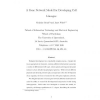Free Online Productivity Tools
i2Speak
i2Symbol
i2OCR
iTex2Img
iWeb2Print
iWeb2Shot
i2Type
iPdf2Split
iPdf2Merge
i2Bopomofo
i2Arabic
i2Style
i2Image
i2PDF
iLatex2Rtf
Sci2ools
ALIFE
2005
2005
A Gene Network Model for Developing Cell Lineages
Biological development is a remarkably complex process. A single cell, in an appropriate environment, contains sufficient information to generate a variety of differentiated cell types, whose spatial and temporal dynamics interact to form detailed morphological patterns. While several different physical and chemical processes play an important role in the development of an organism, the locus of control is the cell's gene regulatory network. We designed dynamic recurrent gene network (DRGN) model and evaluated its ability to control the developmental trajectories of cells during embryogenesis. Three tasks were developed to evaluate the model, inspired by cell lineage specification in C. elegans, describing the variation Corresponding author. 1
| Added | 15 Dec 2010 |
| Updated | 15 Dec 2010 |
| Type | Journal |
| Year | 2005 |
| Where | ALIFE |
| Authors | Nicholas Geard, Janet Wiles |
Comments (0)

